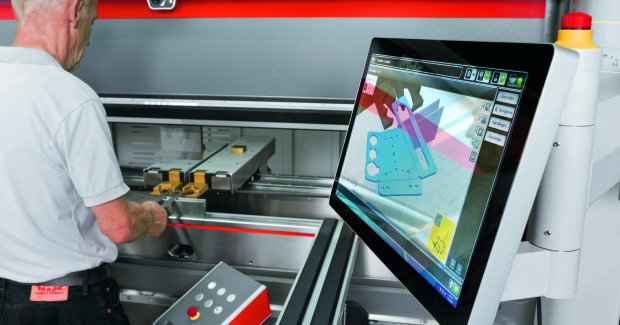The Next Push in High Speed Bending
Take a look at how press brake automation continues to optimize the bending process and integrate with other downstream operations from a high speed laser cutting system to transform the “push” demands of the fabricating process into a competitive advantage for your shop.
Posted: January 7, 2016
It is no longer how a single piece of machinery will affect the metal fabrication process, but how all of the machines and their supporting software technologies work together to create cohesive and effective fabrication business solutions. Optimizing the press brake and other downstream processes from a high speed laser cutting system can transform the “push” demands of the fabricating process into a competitive advantage.
The biggest push in press brake automation is in tool changing for smaller quantity part runs. Shrinking part quantities usually mean more tool setups per day. Automated press brake tool changing supports this by reducing tool setup time and continuing the push toward bending operations where setup up time is effectively eliminated. This, in turn, improves manufacturing efficiency and continues the push toward piece costs being the same no matter the batch size. Higher press brake speeds and automated tool changing increases part capacity, helps reduce the cash tied up in work-in-process generated from high speed laser cutting, and most importantly, reduces the overall process cycle time for job delivery – a key factor often used to command a premium price in job bidding.
Take a look at how this new generation of press brake automation continues to optimize the bending process and integrate with other downstream operations from a high speed laser cutting system to transform the “push” demands of the fabricating process into a competitive advantage for your shop:
Press Brakes Compliment High Speed Fiber Laser Cutting Systems
High speed bending optimizes these press brakes from Bystronic with other downstream processes to help shops optimize the “push” demands of the fabricating process.
Panel Bending Redefined
This panel bending technology from TRUMPF produces positive and negative bends, folds and circular bends with a variety of radii for a significant advantage which reduces set up times and tooling costs.
CAD/CAM Integrated Press Brake Software
Radbend 2016 press brake software from Radan closely links CAD/CAM, Radbend, Radm-ax and Radtube functions with a new style of program and file-type icons for a more unified feel.
Active Crowning Improves Part Accuracy
This patented ACSG active crowning technology from Gaspirini Industries can solve unpredictable press brake forming issues with sheet metal during fabrication.















